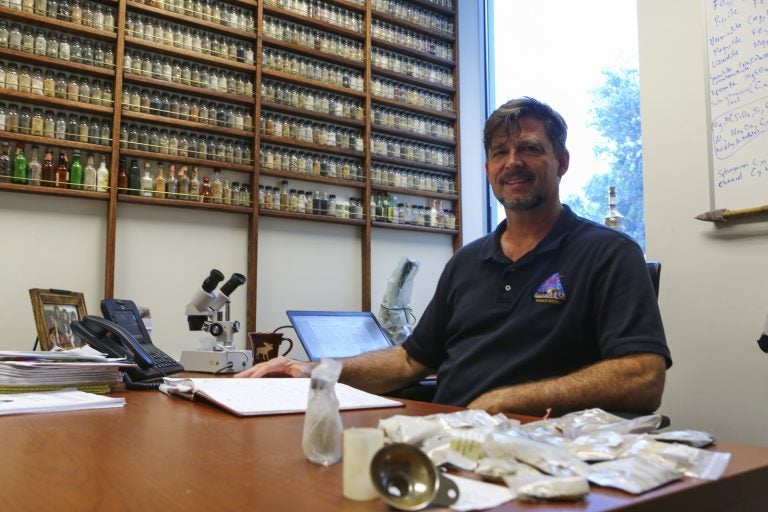As NASA and private space companies look to explore other planets, they are turning to one of the world’s best dirt experts – UCF’s Phil Metzger.
Metzger, who works at UCF’s Florida Space Institute, knows his dirt. He has wall to ceiling spice rack shelves in his office that contain hundreds of samples of dirt from around the globe. His latest sample comes from the beaches of Iceland. It’s his fondness for soil that has led to a career doing some pretty amazing things for NASA and now for UCF.
Currently he is:
“I’m not your typical scientist,” Metzger said. “I started at NASA (Kennedy Space Center) where you look at the economic use of what you’re doing to make space travel more effective, where the mandate was to figure this or that out to accomplish a mission. Here I can combine getting a mission done with the pure joy of answering scientific questions. It’s engineering and science at its best.”
Fluffy Soil
The Resource Prospective Mission is aimed at determining whether there is water on the moon. The hope is to get a rover on the surface of the moon and to specifically look at the poles of the moon where scientists suspect there may be water.
The challenge is that no one has been to the poles and based on technical readings from instruments in orbit around the Moon, scientists believe the soil may be much softer “fluffier” than what is found on earth.
“That’s a problem because if the soil is too fluffy and the rover’s wheels get stuck, then end of mission,” Metzger said.
He’s helping NASA figure out just how “fluffy” the soil is so that the team designing the rover can create wheels, which are less likely to get stuck.
Think of riding a bicycle on the beach. Fatter tires do a better job.
Hopping CubeSats
The World is Not Enough or WINE for short has Metzger working with the private space company HoneyBee Robotics. They are looking at a water based propulsion system to fuel mini-satellites on missions to far away planets and moons. As long as there is water or particles that can be broken down into water, this cubesat system could work.
The idea is that these mini-satellites could be launched into space and then released. They would propel themselves with water vapor to get to their initial asteroid targets. They would collect valuable data, and when they are ready to hop to different asteroids, they would collect materials from their host, break down the soil and convert it into water, turn that into steam, which would then propel them to the next target. As long as there is water, they could keep refueling and conducting valuable scientific reconnaissance missions. They could also ride as hitchihikers to a larger destination like Europa or Titan, where they could hop around exploring. Initials studies show the space hops could be as short as 2 kilometers or 20 depending on the design of the cubesat.
This approach would be less expensive, pose no danger to humans and would collect invaluable data about places never before explored in preparation for future space travel.
3D Printing
A lot has been said about the potential to 3D print items for use in space. Some people like Jason Dunn, one of the founders of Made in Space, see 3D printing as a way to someday build cities on other planets.
Metzger is working with commercial space mining company Deep Space Industries to figure out a way how to make Martian soil pliable and useful for 3D printing.
On Earth, it’s easy because the soil is made up of various properties likes sand and clay. The soil can be treated and converted.
The goal is to have a recipe for converting Martian soil so that when astronauts travel to the red planet they can use the material to build anything from an anti-radiation cover for their bunkers to rope-like structures that could be used to build virtually anything.
Fake Asteroid Soil
Metzger is also working with Deep Space Industries and UCF colleague Dan Britt to develop asteroid simulant – fake asteroid dirt. Asteroids come in various sizes and types. Some are rockier than others and the soil varies. But the depth of our knowledge is minimal. Mining companies and NASA are interested in learning how the soil and rocks on these asteroids interact and react with various instruments as they prepare space missions.
On the practical side, knowing the composition of asteroids that threaten to hit the Earth is critical in devising plans to deflect or destroy them. There are also plans to potentially use asteroids as fueling stations for deep space missions.
“You have to know the soil and how to tap into the minerals to make that happen,” Metzger said. “So a lot of people need the simulants UCF is developing.”
With the fake asteroid material private mining companies can also begin to develop the hardware needed and the protocols to safely mine asteroids.
The father of four says he loves the collaboration among scientists at FSI and UCF so he’s not surprised that more and more companies are looking to the hub of planetary science experts here for help as they race to get people on Mars within our lifetime.
“Yeah, you could say I’m having fun,” Metzger said with a huge grin. “I love coming to work every day. It’s fun.”
